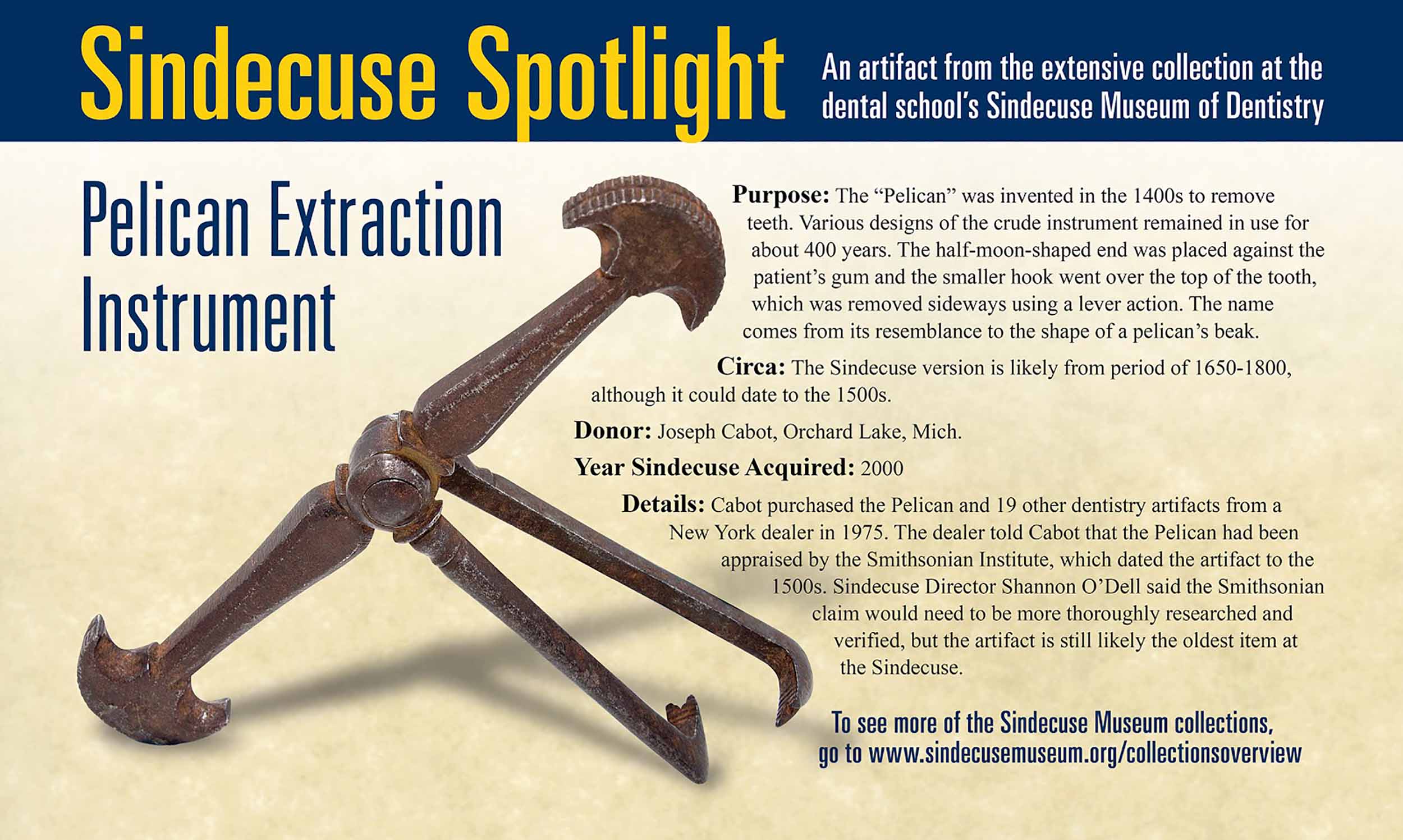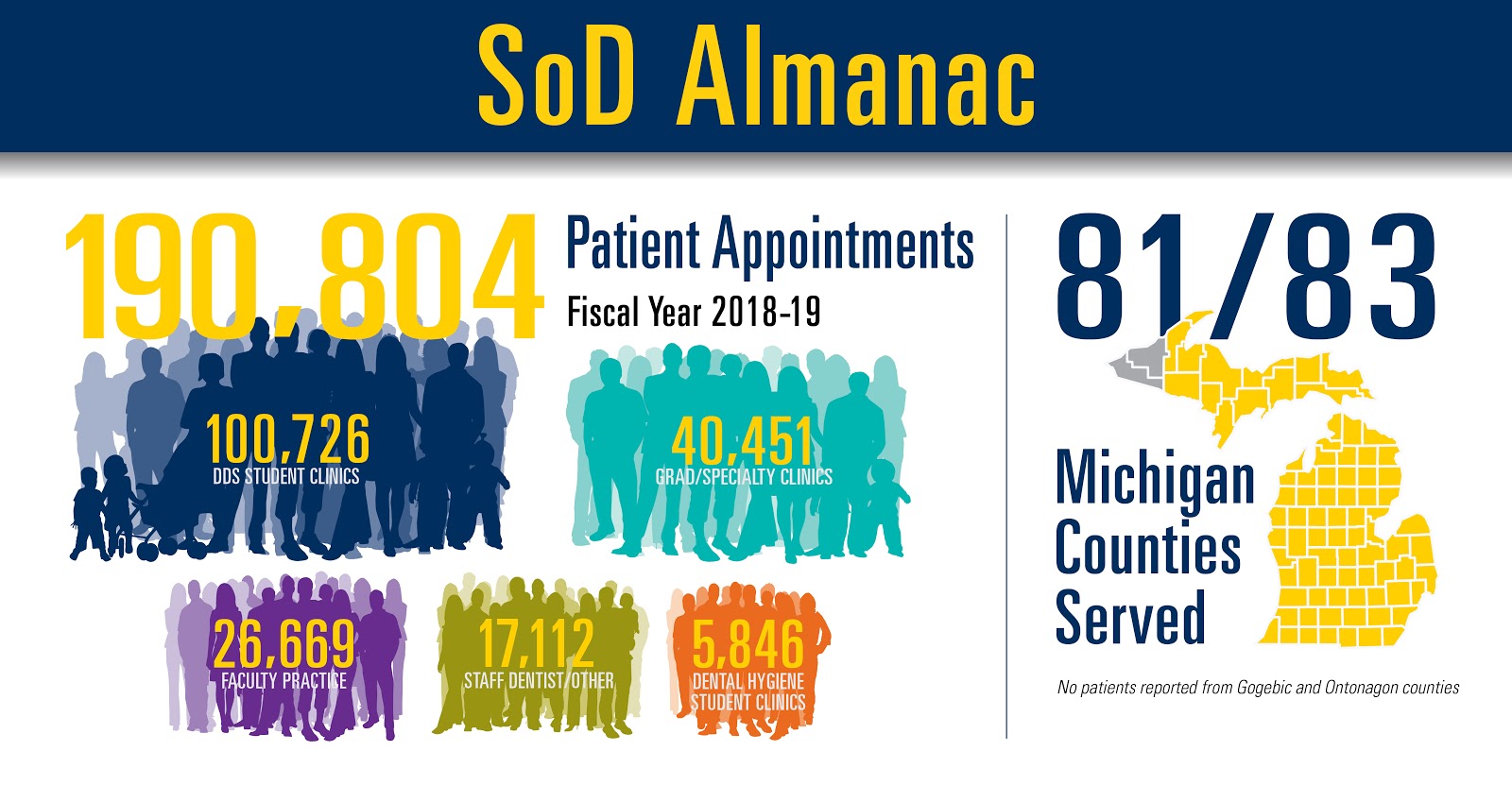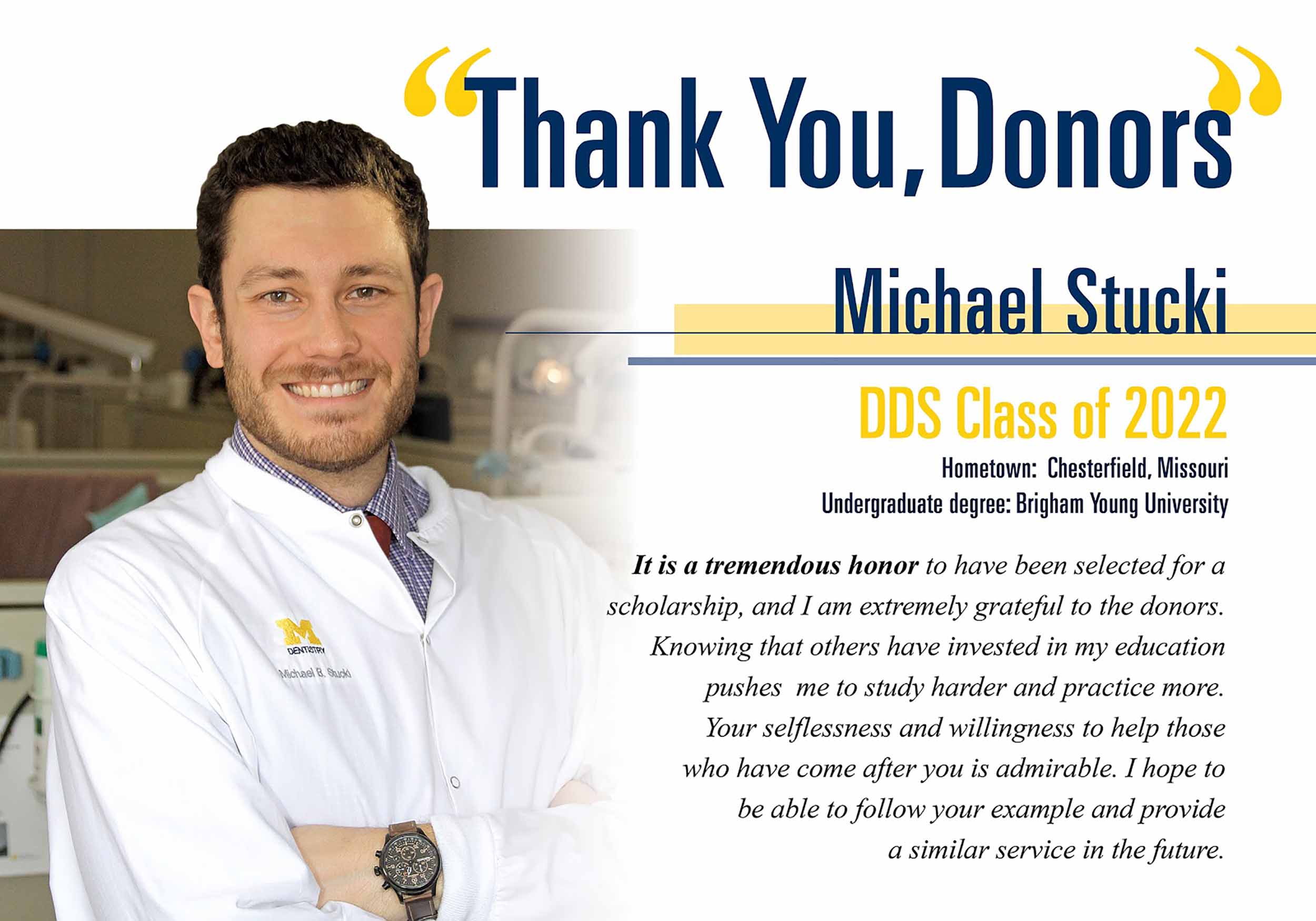School pulls together, adapts to continue mission during challenging time
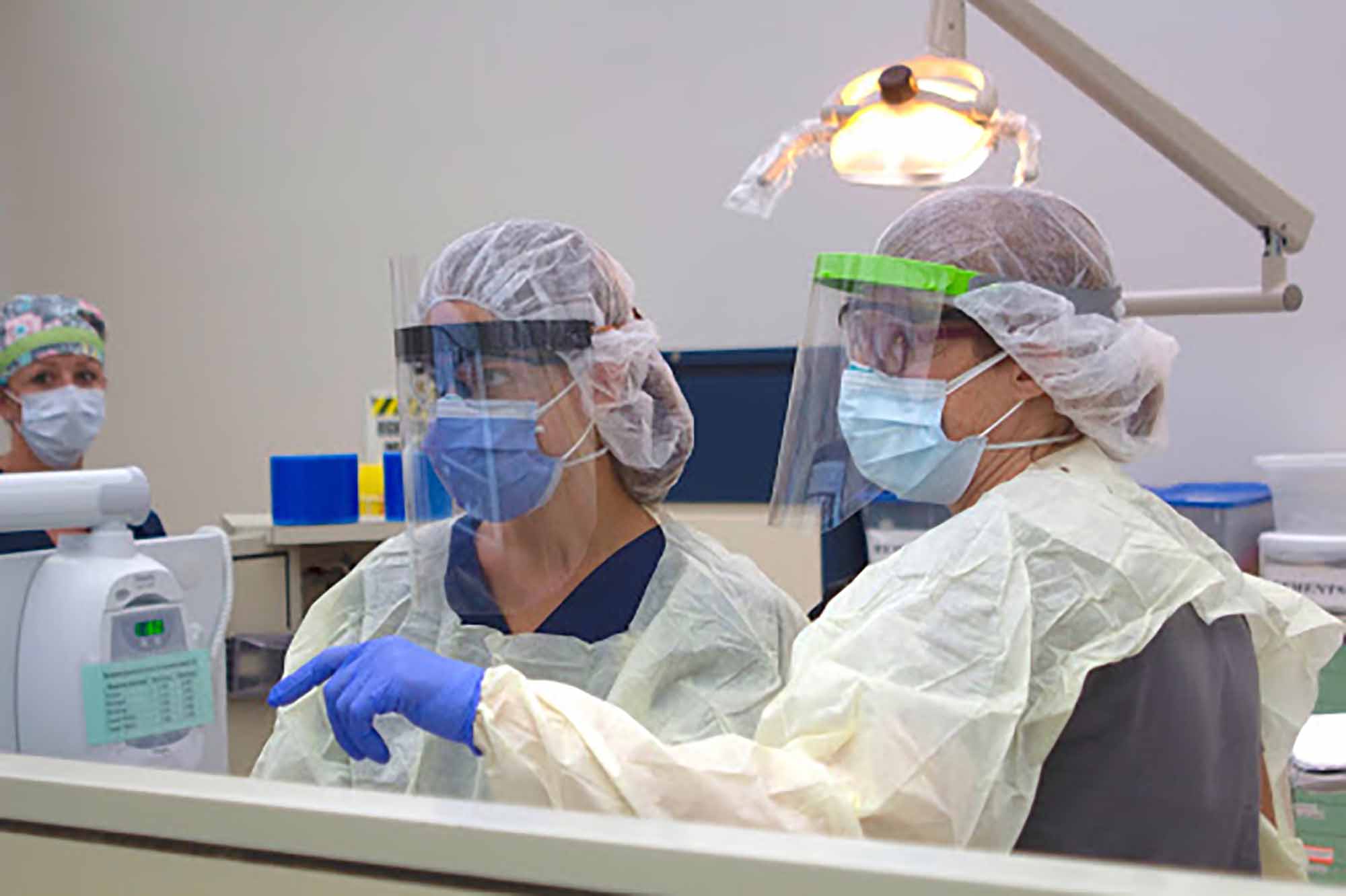
Wearing face shields and other Personal Protective Equipment, Dr. Patricia Doerr (right) discusses a patient case with D4 student Talya Chait as they provide treatment in the Patient Admitting and Emergency Services clinic.
Maintain the mission, maintain excellence.
That was the universally understood mantra that became the touchstone early this year when the impact of the worldwide COVID-19 pandemic first began to affect the School of Dentistry.
Like the rest of the world, the dental school’s long-established educational and healthcare enterprise needed immediate and extensive changes. While no aspect of society was prepared for the sudden and serious transformation, the dental school was able to draw on the collective expertise and energy of its world-class community of administrators, faculty, students and staff.
Since its founding in 1875, the school has weathered storms – the World Wars, the 1918-20 flu pandemic, the Great Depression and various other global conflicts and economic recessions. Amid those difficult times, the school continued to produce graduates who went out into the world to improve the lives of countless people over the generations. This pandemic requires the same determination and focus.
“The challenge, and ultimately our success, is our adaptability while holding tight to our mission and core values,” Dean Laurie McCauley told the school in the early weeks of the crisis. “These are challenging times and challenging times are marked not only by the events that occur but also by the people who work to create a new reality and to solve problems. Change is not easy, but when we embrace what we can do, instead of what was, we accelerate and increase collective, positive outcomes.”
McCauley said the dental school benefitted from having an impressive roster of faculty, staff, students and administrators who were already contributing to the school’s world-class operation. When the pandemic hit, their focus shifted into a 24-7 problem-solving mode as they triaged the long list of pressing problems to be solved. The school’s mission statement – “Advancing health through education, service, research and discovery” – was the backdrop for dealing with the worst public health crisis in a century.
In the first week of March, two weeks before the university announced its decision to send students home and reduce on-campus operations, McCauley appointed a COVID Response Group, comprised of administrators and faculty. It quickly focused on five areas – Patient Care, Education, Research, Human Resources, and Facilities.
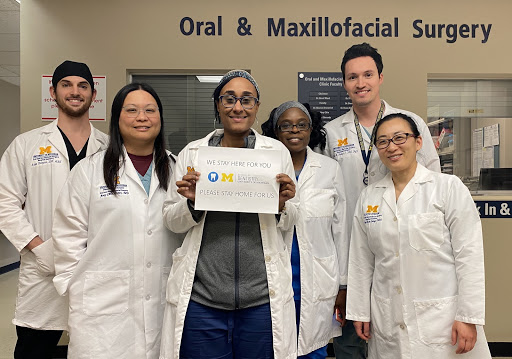
“We stay here for you, please stay home for us” is a sign displayed by members of the Oral and Maxillofacial Surgery department in a photo taken in mid-March before social distancing and facemasks became required protocol. From left are Dr. Aram Keteyian, Dr. Amy Chin, Patient Services staff member Colletta Haley, Dental Assistant Paulette Maazza, Dr. Jose Ramos and Dr. Hsiao Sung.
The first priority was, and still is, the safety of everyone at the school – patients, students, faculty, staff. Despite the fact that the school’s normal operations already included extensive infection control protocols for clinical care, the pandemic required a significant increase in planning, expense and action to expand the previous standards not only in clinics, but throughout the entire building. Even as the safety protocols were being strengthened, the next major imperative for the response group was to determine how the curriculum could be transferred to remote learning. A team of administrators, faculty, curriculum support staffers and technology experts pulled off the move to remote instruction in a remarkably short period of only a few days.
While changes to clinical care and delivery of the curriculum were the initial huge problems to solve, countless other issues needed to be solved every day during a state, national and world crisis that was changing hourly, daily, weekly.
“We didn’t and still don’t have all the answers, but we do have the dedication and collaboration to carve out an informed pathway as we move forward,” McCauley said. “I am incredibly impressed with what has been done to pull together during this time, in particular how creative, innovative and engaged our community has been. For instance, the way our faculty turned on a dime to change the way they deliver our education. The way our students adapted to new learning platforms and showed their resilience. The way our staff stepped up and continued to support our school, either by working at home or the cadre of those who are still coming into the school. This dedication and collaboration is a heroic effort, particularly because each and every one of our employees was also dealing with the pandemic on a personal level with their families.”
The variety of problems was relentless, with new ones emerging daily in a complicated domino effect where one action would require another action that would require a third and so on. The following sections summarize how key areas of the school were managed when the pandemic arrived.
Treating patients in a pandemic
Dr. Romesh Nalliah, Associate Dean for Patient Services, led the COVID Response Group, which not only needed to develop immediate action plans if the university were to reduce operations, but it also needed to think ahead to coming weeks and months and how each decision would support the school’s mission and day-to-day operations going forward into an unpredictable future. As director of all areas related to patient care, Nalliah led a group who developed protocols for protecting patients and their dental school providers from the coronavirus as students and faculty continued to provide clinical care in early March. By the third week of March, after the university and school ended on-campus instruction, the school implemented a plan for providing only emergency care for patients who had no COVID-19 symptoms.
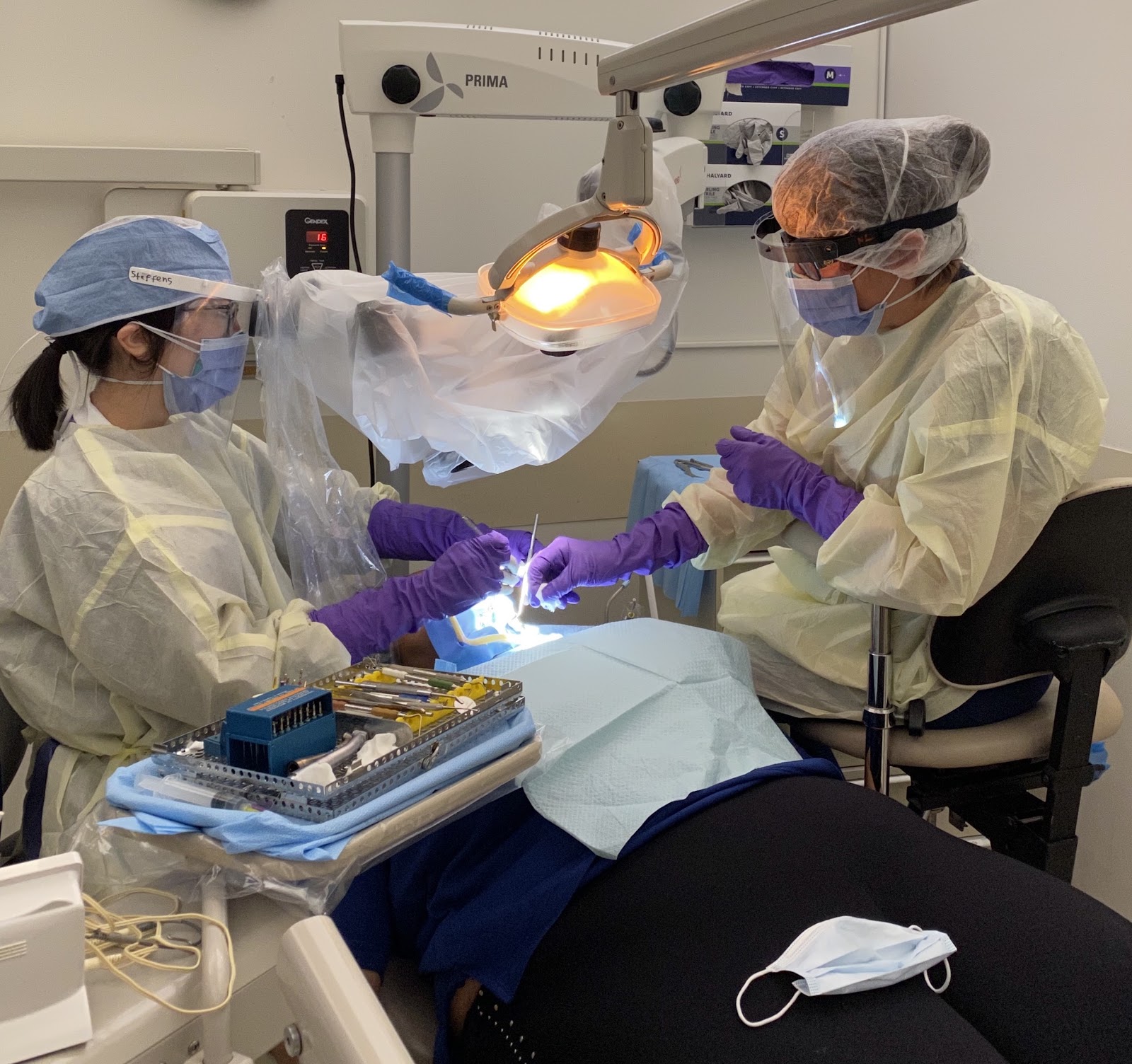
Dr. Rebecca Steffens (left), a resident in the graduate endodontics clinic, looks through a face shield into a microscope as she treats a patient during an emergency procedure in the early weeks of the pandemic. At right is dental assistant Nancy Lako.
Nalliah said the school’s mission statement played a role in decisions. “When we decided to close our clinics except for emergency care, we planned a week of stabilizing our patients instead of a complete and sudden shutdown. This was guided by our mission of advancing health,” he said. “When we decided to remain open for emergency services to all patients – new and existing – it was guided by our mission to advance health. During those weeks of the state shelter-in-place order, about 85 percent of the emergency patients we saw were new to our practice, and that was a critical service we provided in our community.” The school treated 50-70 emergency patients per week who otherwise might have sought emergency care at the U-M hospital, which by then was inundated with COVID-19 patients.
All types of emergency treatment were provided, but safety protocol limited care to four clinics – Patient Admission and Emergency Services (PAES), Endodontics, Oral Surgery and Pediatrics. They were staffed by a small group of faculty from various departments, dental assistants and a few student volunteers who each day donned extensive personal protective equipment in order to keep both patients and providers safe. The 50-70 patients treated each week were among a much larger number of phone calls that came in, from 400-700 a week, which staff in the Appointment Office screened for the emergency-only criteria. Working with technology staffers, the school also enhanced its teledentistry options so that Patient Services staff dentists could perform remote video or telephone screening of patients.
The Office of Patient Services remained open and key staff members were present every day in Guest Services, Dental Stores, Central Records, Sterilization, Dispensing, Dental Auxiliaries, PAES clinic, Appointment Office, Patient Business Office, and the Information Desk. The school’s Community Dental Center in downtown Ann Arbor remained open and treated some of the emergency overflow from the dental school.
Nalliah credits previous school leaders, including his immediate predecessor, Dr. Stephen Stefanac, with having put in place an excellent clinical care system staffed by dedicated staff members. For example, he notes that few if any schools have a full-time infection control position like the one the school has had for more than a decade. When the pandemic hit, myriad aspects of infection control needed to be implemented from existing protocols or developed as new procedures based on the unique problems of a coronavirus pandemic. Nalliah credits Brandonn Perry, Infection Prevention and Compliance Officer, with providing thorough expertise and conducting expansive research to keep patients, students, faculty and staff informed about effective infection control, including extensive training about how to wear and use Personal Protective Equipment (PPE).

Brenda Richards, dental dispensing assistant, takes the temperature of a patient in the first design of the building entrance health check station in March.
Limiting access to the building and screening those who entered was a more complex task than expected, Nalliah said. Entry was limited to two entrances with screeners doing temperature checks and asking questions of each person entering the building, whether they be staff, patients, students, faculty, researchers or, eventually, construction workers who returned to the building after several weeks. University guidelines were different for researchers, for example, than others, and national guidelines for patients changed frequently.
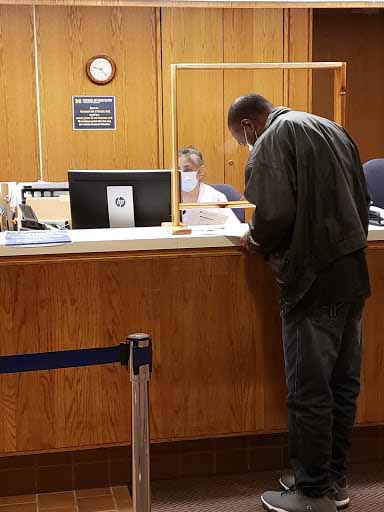
A plexiglass screen is part of the infection control protocol for patients checking in at the main reception area.
During May, separate committees had been established to guide Predoctoral and Dental Hygiene clinic re-entry planning and Graduate clinics and Dental Faculty Associates re-entry planning. Dental students began returning to clinical care delivery on June 10.
Nalliah said the pace of making big decisions rapidly required nearly constant meetings, often by Zoom since most staff members were working from home. The demands of the clinical care area meant Nalliah was at the school most days, as were several other key people he needed to consult regularly, including Dean McCauley, PAES Clinic director Dr. Patricia Doerr, and Brandonn Perry. While that made efficient in-person discussions possible, there was still a relentless schedule of Zoom meetings, sometimes back-to-back all day long, as well as regularly in the evening and on weekends. Finding time among the meetings to answer a similar flood of emails, sometimes 100 a day, was another challenge. “I think every member of the School of Dentistry family worked evenings and weekends. There was an incredible commitment from department chairs, deans, faculty, staff and also students, who served on many committees,” Nalliah said.
Revamping the curriculum on short notice
Converting the entire curriculum to remote learning in less than a week was a herculean task in mid-March. Dr. Diane Hoelscher, Interim Associate Dean for Academic Affairs and a Clinical Assistant Professor, said the feat was accomplished because of a team effort by “our amazing faculty,” instructional designers in Dental Informatics and staff in the Educational Support Services office. Faculty were able to migrate their content to Canvas, the university's learning management system. They assembled a combination of previous lecture videos and new recordings. The dental school instructional designers conducted webinars and developed comprehensive instructions for faculty who were adapting to technology and software they had never used before. A new Canvas course just for faculty called Virtual Classroom 101 provided guidance on how to conduct online courses.
Hoelscher said a second immediate concern was reviewing and determining requirements for graduation by the Class of 2020. This was a collaborative process with the discipline coordinators and faculty directors of the Vertically Integrated Clinics. “We had to strike a balance between what could realistically be accomplished given the shutdown of clinical patient care, while maintaining our usual high educational standards and meeting CODA accreditation requirements,” Hoelscher said. “Because we had intentional redundancies for certain test cases and good documentation of student procedures, we had a clear picture of students’ progress toward competency. Most students were complete and a small number had to return for either simulated or actual patient care for final assessments or essential procedures.”
When CODA provided new information regarding flexibility with which schools could meet their standards, discipline coordinators were able to develop simulated activities to meet clinical test cases and required procedures. For example, prosthodontics faculty used 3D printers to make removable partial denture frameworks with errors to provide students the opportunity to critically think and problem-solve delivery of a removable prosthesis.
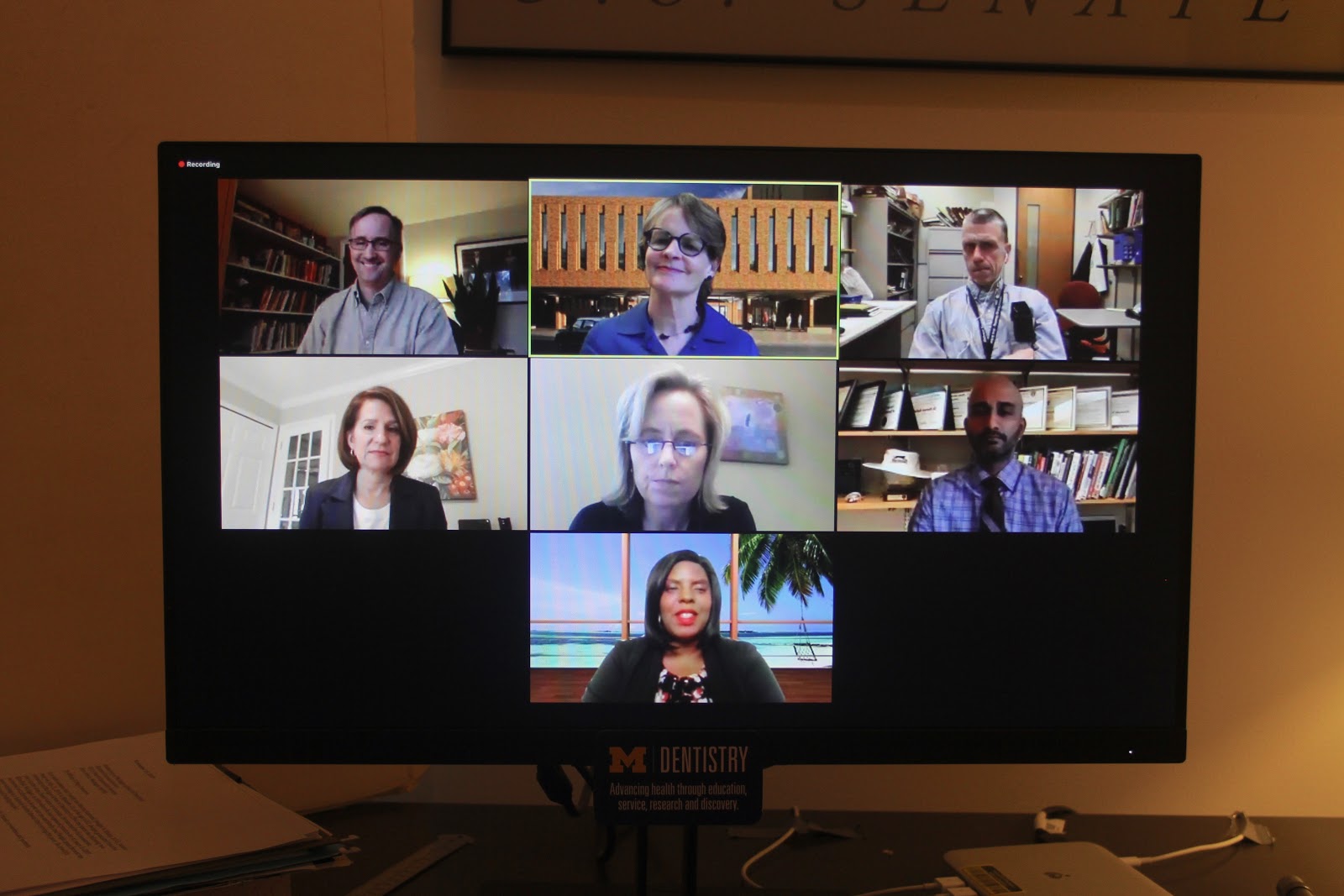
School administrators are shown during one of several Zoom online townhall meetings that have been held for the school community. Top row, from left: Ray Aldrich, Director of Marketing and Communication; Dean Laurie McCauley; Vesa Kaartinen, Associate Dean for Research. Middle row, from left: Diane Hoelscher, then Interim Associate Dean for Academic Affairs; Renée Duff, Assistant Dean for Student Services; and Romesh Nalliah, Associate Dean for Patient Services. Bottom: Natalie Brown, Director of Human Resources.
Because things were rapidly evolving and there were so many unknowns, faculty member Dr. Mark Fitzgerald, Associate Dean for Community-Based Collaborative Care and Education, led a team that planned modifications to the curriculum moving forward into spring-summer and fall terms. The school wanted to assure that students continued through their dental education as seamlessly as possible. That required modeling different scenarios and making best guesses at predicting the future – for example, that students would be able to return to preclinical instruction in the Sim Lab on June 22. Each scenario required extensive analysis to make sure each cohort of students would be completing the correct mix of requirements, even if not in the same order as has been the practice for many years. Planners worked from a worst-case-scenario approach in the modeling because it would be easier to accelerate if conditions improved, rather than have to pull back and redesign because of an overly optimistic plan.
In creating a new spring-summer term, Fitzgerald and his team had to plot minimum credit hours, rearrange the order of courses, create new schedules and some new curriculum for all four cohorts, and negotiate with directors of courses that had been moved out of their normal order. A major task was figuring out how to catch up on pre-clinic sessions that were lost when students moved off campus. Returning students to Sim Lab was complicated since it was under construction as part of the major Blue Renew renovation project underway at the school. A new maximum capacity was arranged that meant rotating through 55 students at a time as opposed to the total 110 benches that would normally be occupied by an entire class. Lost clinical rotations were identified by content and time needed to complete, and new schedules were created, though that has been slowed by the continued limited availability of PPE. Once the spring-summer problems were solved, planning started immediately for the fall.
“It was truly a team effort,” Fitzgerald said. “The variety on the team – faculty, staff and key contributors from all around the school – increased our ability to adapt to a constantly changing environment, predict potential obstacles and identify non-traditional solutions. There was and still is a constant sense of urgency, but not chaos. Self-imposed deadlines worked very well for keeping the process on schedule.”
Janet Kinney, director of the school Dental Hygiene Program, was a member of Fitzgerald’s committee. She represented the similar but different problems faced in making sure the DH Class of 2020 finished its requirements, followed quickly by the arrival of the Class of 2022. Like Fitzgerald, Kinney praises the cooperation and collaboration among faculty and administrators as problem after problem was solved. Early on, the pressure was to make sure the senior class fulfilled graduation requirements. “The Class of 2020 was a resilient group of young people,” Kinney said. “They learned some pretty hard life lessons here, all in a very short period of time. But they really did try to just accept it and move forward.”
One of the other early requirements was converting the usual in-person orientation to an online welcome for the new DH students. It was developed through Instructional Services and proved to be a valuable exercise for developing a similar orientation for the incoming DDS class several weeks later, Kinney said.
Online learning from home meant the new DH students didn’t have access to a variety of tools they would have at the school, so the program purchased plastic teeth and skulls, along with dental instruments, and mailed them to each of the 32 students so they could learn and practice at home as instructors taught online. An example of the new online educational world is that the DH students are required to use their iPads to record videos of themselves using the instruments on their models in order for faculty to assess their progress.
Kinney said the school’s technology staffers and Educational Support Services staffers offered invaluable support in what was an ever-changing environment. “You learn that you can have great plans, but they may need some tweaking or total revision in a heartbeat,” she said. “I think the faculty have done beautifully overall. And part of that is school resources were available very quickly for someone who maybe wasn’t comfortable in an online environment and needed to get up to speed. They have helped each other and supported one another really, really well.”
Students demonstrate resilience in the face of major changes
Dr. Renée Duff, Assistant Dean for Student Services, was involved in COVID-19 response starting in late February when she advised students on health and safety guidelines and travel advisories for spring break. Once the school moved to distance learning in March, the ensuing weeks and months have been a constant series of meetings and interactions necessary to plan, troubleshoot, communicate and answer questions that often didn’t yet have answers. It was common to have as many as a dozen video-conferences or other types of group meetings and discussions each day, during the evening and on weekends. “In an uncertain and rapidly changing landscape, critical information would change from the start of a one-hour meeting to the end. It made making coherent, timely communication extremely challenging,” Duff said.
In addition to working with the administrative team, Duff collaborated with the admissions, registrar, financial aid and counseling staff to develop procedures and solutions in many areas affecting students. Some of the areas that were addressed include community safety; student travel and housing considerations affected by the rapid change to remote learning; ensuring that the last term for the Class of 2020, which lost clinic time among other changes, would meet graduation and licensure requirements; developing an online commencement celebration for the Class of 2020; decisions and communications about the curriculum and procedures for the spring-summer and fall terms; reviewing grading policies to mitigate the negative impact of students adapting to online classes; ensuring uninterrupted student services such as financial aid and counseling for students no longer able to be assisted in person; and finding ways to build community among students who had lost the in-person camaraderie of being at the school.
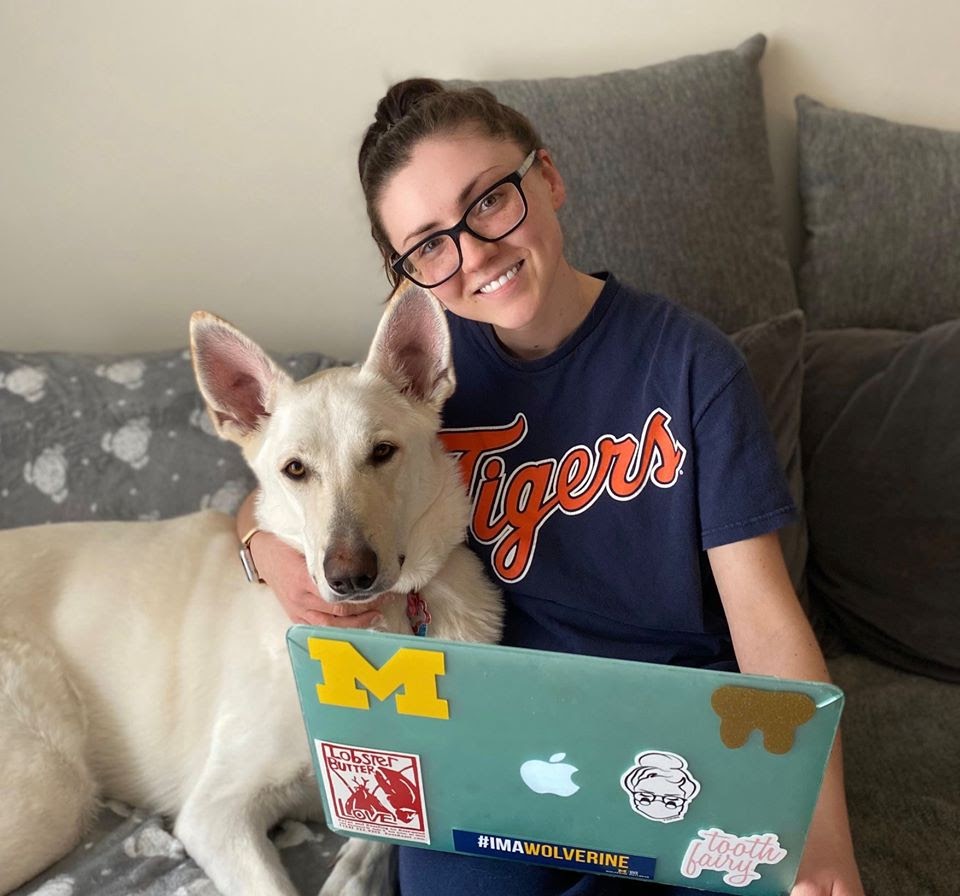
Taylor Hamilton, DH Class of 2021, has the company of her dog Nymeria as she participates in an online class at her home in Ann Arbor.
Another asset for students was the previously planned start of the Faculty Coach Program, led by faculty member Dr. Stephen Stefanac. The program began in March when 12 faculty coaches taught an online course in patient care for D3 students. The program is designed for the coaches to eventually manage a group of about 22 students in their D3 and D4 years. The faculty and students meet regularly – currently by Zoom meetings – to review patient case progression and student professional development. The coaches monitor and assess student activity by working with the school’s patient care coordinators and consulting an electronic dashboard with metrics for each student’s patient family. Stefanac said the planned start of the Faculty Coach program early this year was good timing because the pandemic disrupted students’ normal educational routine, which created problems and questions that could be shared within the structure of the new program.
Thomas Havlichek, a D3 student who is president of the Class of 2022 and president of the Schoolwide Student Council, moved back to his parents’ home in DeWitt, Mich., when U-M closed its campus in mid-March. He and some friends thought the exile from campus might last three or four weeks, but it turned into more than three months, the longest time he had spent at home with his parents since high school. He said the first few weeks of online courses and communication were the most difficult for students as they adjusted to watching video-recorded lectures and new types of assignments. They found themselves on Zoom meetings several times a week and sometimes several times a day. The online conferences had to be scheduled at a time that worked for all time zones since students were spread throughout the country.
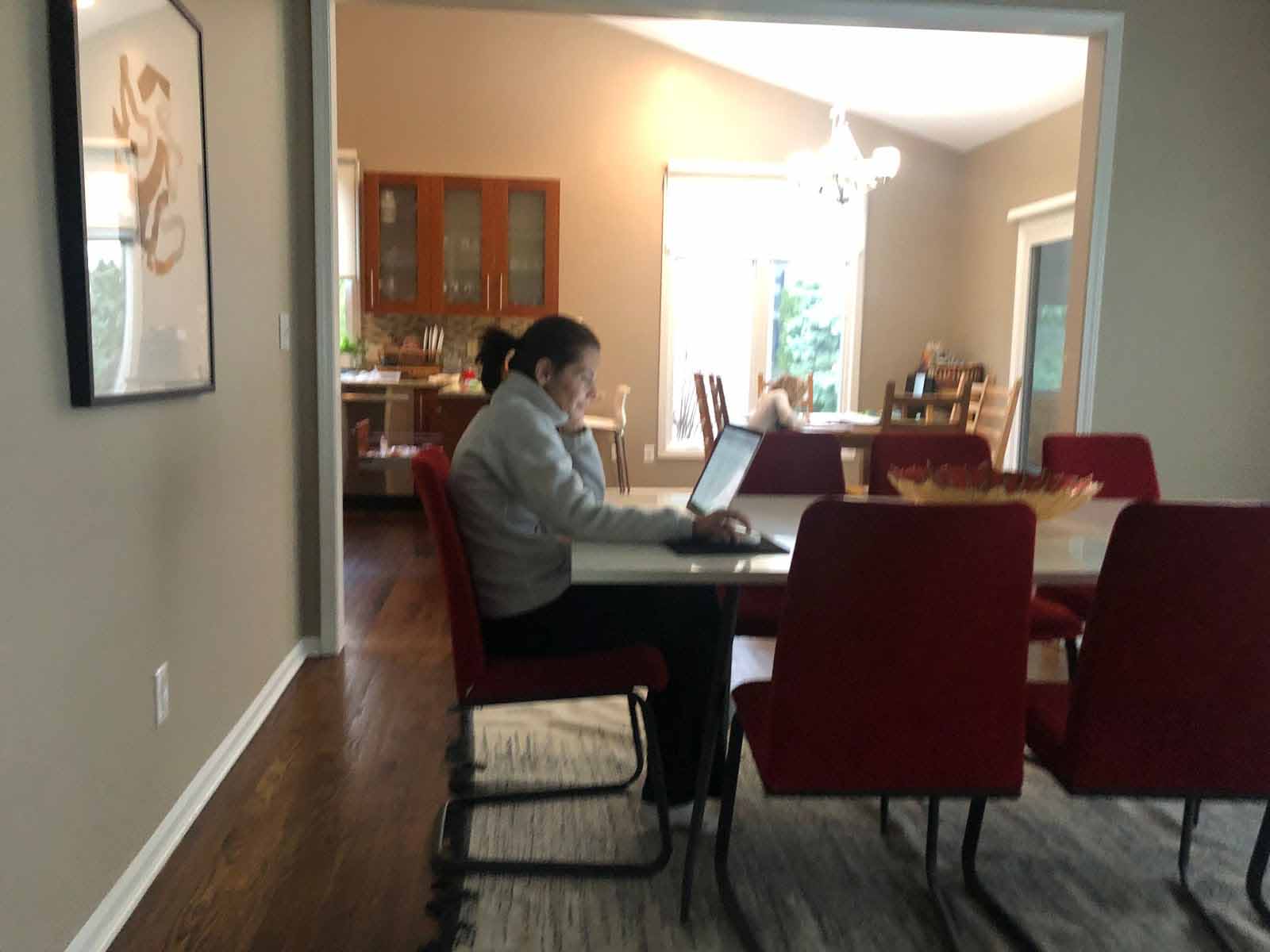
Elisabeta Karl, Clinical Assistant Professor in the Department of Cariology, Restorative Sciences & Endodontics, sits at the dining room table in her home as she teaches online.
“What made it more challenging was there were many more questions than answers,” Havlichek said. “Student council members were frequently contacted by classmates to figure out what was going on, but the school didn’t know how they were going to move forward. The uncertainty was stressful for many students. When would we would return to clinic? When would we finish our Sim Lab coursework that was cut short in the winter semester? What is the new normal going to look like as dental students and as a school? Throughout the summer semester, communication from the school increased and questions started getting answers. It took two or three weeks, but once the kinks were ironed out, the semester progressed in a logical and organized fashion. There are still some loose ends to tie up, but the school is working diligently to do so. Looking back, it is striking how much work was done in a short time to transition dental school to online learning.”
As the calendar moved into the spring-summer session, there were significant differences to the usual order of courses. The summer session for D3 students is typically clinic-based, but clinic capacity is limited because of pandemic infection control restrictions. The solution for administrators was to move several didactic courses from future semesters into the summer semester. After looking forward to mostly being in clinic for their final two years, the D3 class was disappointed at the prospect of having another heavy didactic course load, Havlichek said, but it was an understandable option given the circumstances. Moving the order of courses created challenges for both faculty and students when assignments or videos were not uploaded on time. Students had to figure out how to stay organized in a new learning format.
“The past few months have been a challenging experience for everyone,” Havlichek said. “Throughout it all, the school and students demonstrated flexibility, understanding and care for one another. We’re making the most of online dental school and are looking forward to returning to ‘normal’ as soon as it is safe to do so.”
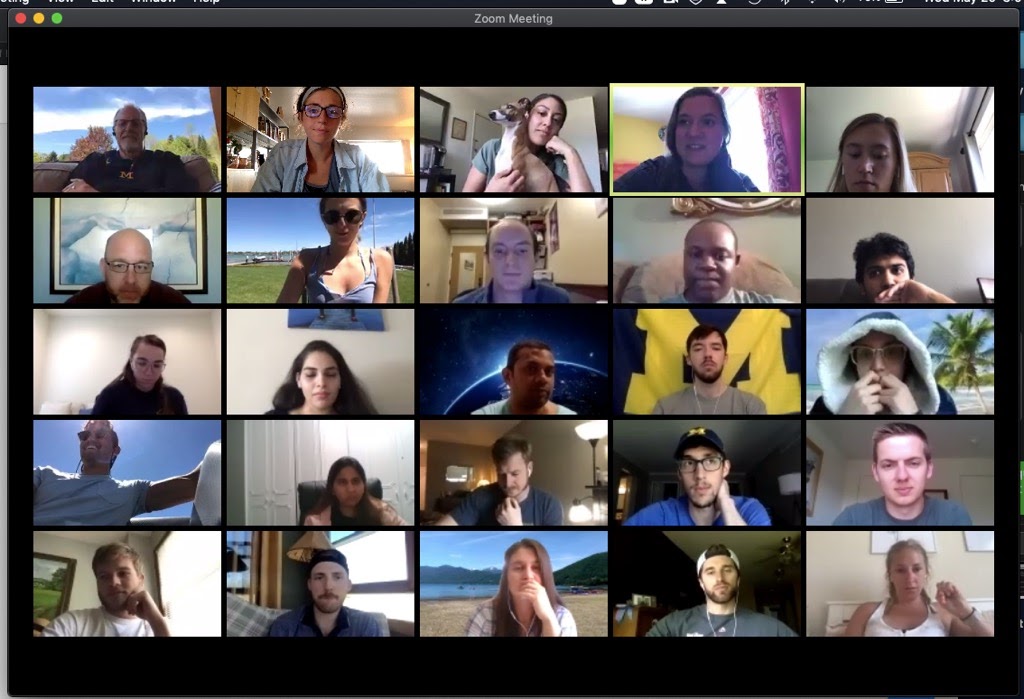
DDS students gather ‘round the Zoom screen during an online class with Dr. Dennis Fasbinder. Photo courtesy Sarah Swartz-Bouwkamp, Class of 2022.
Research carries on
When the university shut down research laboratories across campus for safety reasons during the pandemic, the benches in the research tower at the dental school went dark. The only functions permitted were related to maintaining equipment and preserving research specimens. For professors and members of their labs, including graduate students, postdocs and various other researchers, it was a shocking halt to their daily routines of investigating a wide range of science, from the building blocks of craniofacial development to regenerative medicine to head and neck cancer.
Dr. Vesa Kaartinen, Associate Dean for Research, and his staff in the Research Office, closely monitored the university’s guidelines for shutting down “all non-critical research activities” on March 20 and coordinated with faculty and staff. After a two-month hiatus, the University Office of Research devised a highly detailed system of returning to the labs in carefully controlled “waves,” which again required continual coordination between the Research Office and faculty researchers. The gradual return to labs began in June and is continuing.
The research of Dr. Noriaki Ono, associate professor in the Department of Orthodontics and Pediatric Dentistry, focuses on the fundamental biology of stem and progenitor cells of the bone cell lineage in growth, development and homeostasis. He described the lab closure as “a huge disruption” to his lab activities, which include mouse modeling. “From March 20 to June 8, we basically focused on doing something else such as preparing manuscripts or writing grants,” he said. “We have submitted two manuscripts for publication and two grant proposals. But it's not like our research could go on without the benchwork.”
Dr. David Kohn, a professor in the Department of Biologic and Materials Sciences & Prosthodontics and professor of biomedical engineering in the College of Engineering, said the lab closure had a significant impact on his research, lab personnel and budget. “We had to shut the lab and abort experiments on very short notice,” he said. “That meant we had to absorb the costs of the aborted experiments, which was more than $10,000.” There were human costs as well because his research assistants lost research time, which causes concerns about how it will affect progress toward their degrees or entering the job market.
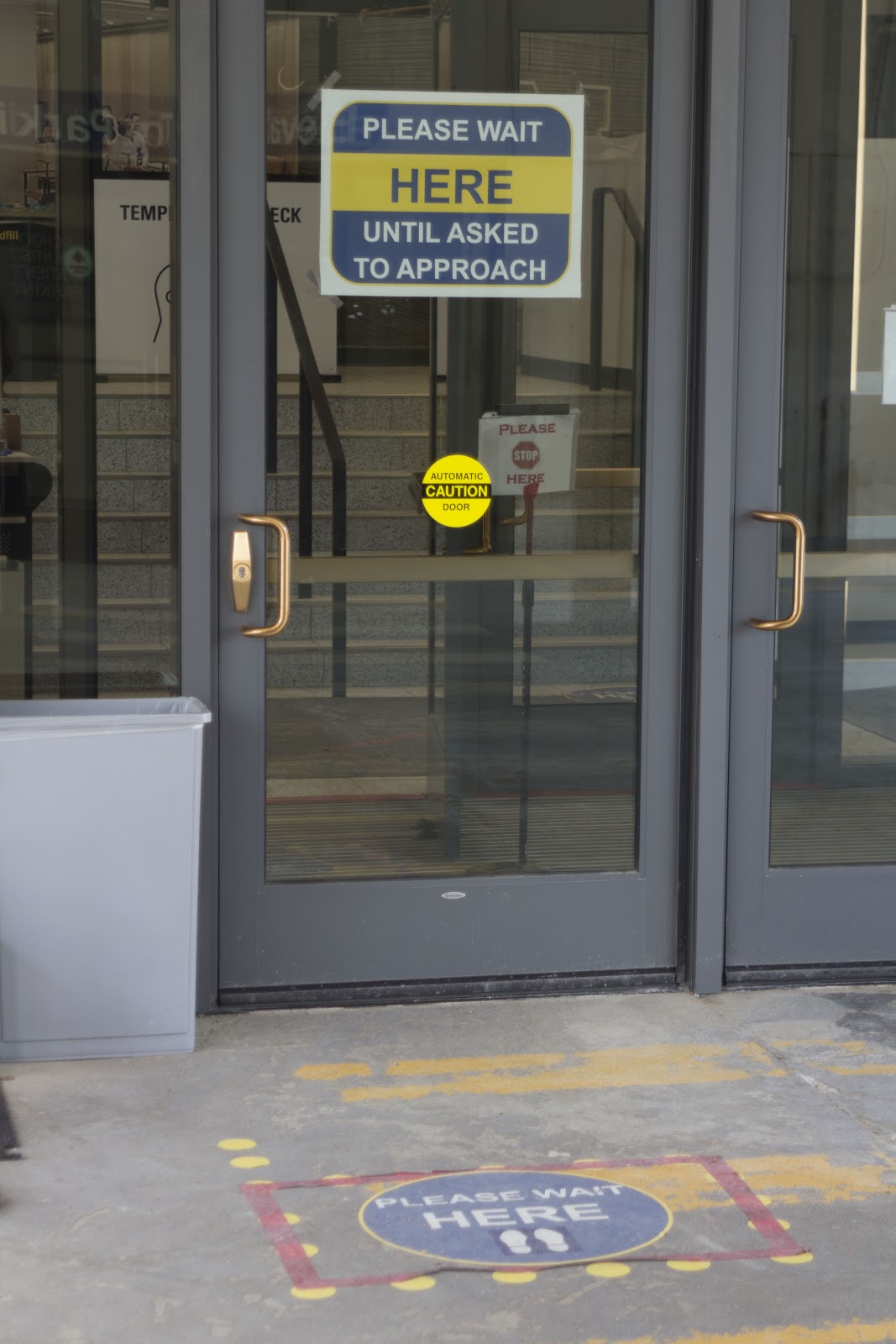
A sign on the door and a space marked on the pavement provide guidance about screening protocol for patients and others who approach the North Entrance to the dental school.
On the plus side, Kohn said he was busier than ever as he continued to direct several large research programs, including the Michigan-Pittsburgh-Wyss Regenerative Medicine Resource Center, which recently received the largest grant in school history. Kohn said he continued to engage his lab personnel and wrote six papers, grants and progress reports during the lab closure. He also described being “Zoomed to death” with online teleconferencing calls. “Some days I started at 7 a.m. with a call to collaborators in Europe, then had online meetings all day with people at U-M and around the country, then I’d finish in the evening with a call to collaborators in Australia.”
A few research projects that were tied to the pandemic went forward, including a dental school collaboration with the U-M College of Engineering and the Office of Patient Services. It will gather more definitive data on how COVID-19 is spread in aerosol form, which is important given various high-speed instruments used by dentists. Dr. Romesh Nalliah said a team from engineering will use high-speed photography to track how aerosols droplets travel outside of a patient's mouth.
They will then take it one step further than previous research by using computer-aided artificial intelligence to project the trajectory of droplet nuclei, which are too small to photograph but extremely important in understanding the transmission of COVID-19. Previous research also was limited to private practices or single operatories; the new project will be for a larger clinic setting. Nalliah said results will enable the dental school to make evidence-driven decisions rather than arbitrary ones about how clinic cubicles should be configured and protected, whether certain procedures should be isolated and the distribution of Personal Protective Equipment.
The School of Dentistry also joined a national effort to increase antibody testing related to the COVID-19 pandemic and added a research element to the effort. In April, May and June, the school set up a testing site for local front-line healthcare workers; faculty, staff, and students of the school; first-responders; and essential workers. Those being tested had the option to participate in a research survey to collect demographic, exposure risk, quality of life, and testing results. That data will help determine the level of immunity to SARS-CoV2 in the test group and answer many other questions related to risk determinants and impact of the disease.”
Dr. Robert Eber, a Clinical Professor in the Department of Periodontics and Oral Medicine and the Director of Clinical Research, led a faculty team that included Dr. Margherita Fontana, Dr. Mark Fitzgerald, Dr. Brent Ward and Dean McCauley. Also participating were faculty volunteers, several dental students and numerous staff members from across the school, including information technology, patient services, business and billing.
The vital role of the technology staff
Cassandra Callaghan, Chief Information Officer, and her staff of about 20 in Dental Informatics (DI), were immediately on call in countless ways that assisted students, faculty, staff and researchers in every corner of the school – and in their homes as well since the majority were forced to suddenly work from home.
Because many of the school’s staff members had never worked from home before, there were many tasks to complete and questions to answer about computers and online connections. Staffers without computer equipment at home were allowed to take their work desktop or laptop computers home. Additional laptops were procured to ensure everyone would have the ability to work from home. In addition to responding to individual questions as employees set up their home systems, DI quickly created an extensive online Working Remotely Guide with instructions and best practices for working at home.
“Remote access impacted all missions of the school,” Callaghan said. “We had to find solutions so that anyone who needed to access School of Dentistry resources could do so. One example that was really important was to have a secure way for faculty, staff and students to access Electronic Health Records and stored images.
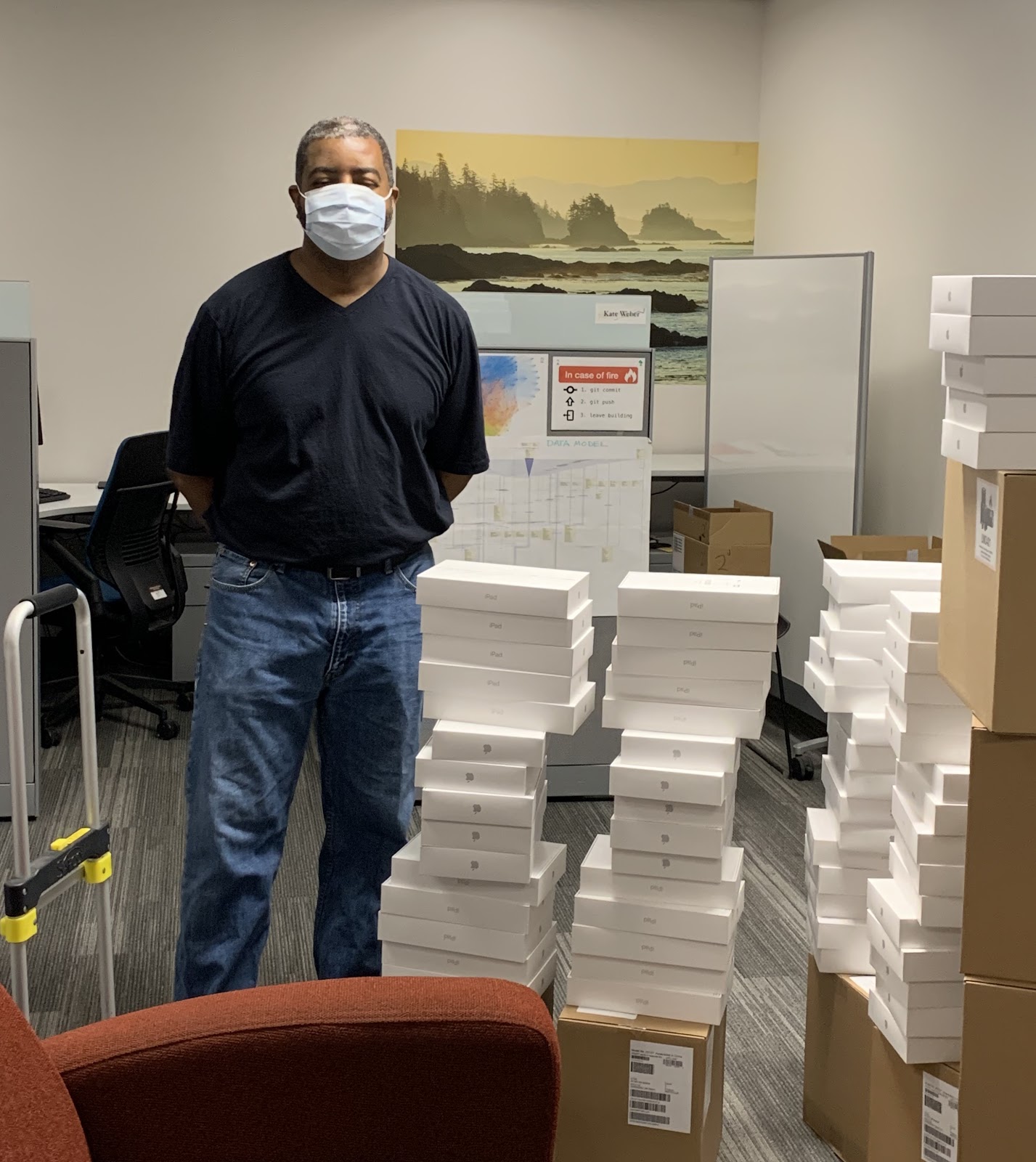
Dion Taylor, a senior data security analyst in Dental Informatics, stands next to some of the 400 new iPad computers that were distributed to students shortly after in-person classes were canceled in March and students began working remotely.
We had never given students remote access to those before. We put a creative solution in place to enable many users to access these systems remotely, including students who need it for some of their educational requirements.”
Also among the early actions by the school was the decision to purchase and distribute new iPad computers to students who would be D2s and D3s during the 2020-21 academic year, along with the incoming D1 class, the new Dental Hygiene class and those in the Internationally Trained Dentist Program. (D4s were not included since their final year is mostly clinical care.) Altogether, about 400 iPads were distributed by DI as a way to ensure students were on equal footing in terms of computing power and current software, as well as to allow for more engaged online learning methods with faculty as part of a plan developed by a task force for the iPad platform.
Other essential and time-consuming accomplishments by DI included:
- Moving all spring and summer classes online, which required extensive consultation with DDS and Dental Hygiene faculty and administrators. Work continues on doing the same for fall courses.
- Developing a virtual classroom guide and engaging with faculty through consultations, webinars and one-on-one support to advance best practices for teaching online.
- Deploying Zoom Healthcare videoconferencing technology by providing extensive documentation and individual support for the meetings and webinars that have become the go-to standard for group meetings.
- Implementing a teledentistry solution so that clinicians could assess patients by video conference, a process that included developing a guide for patients, a webpage and support for clinicians.
- Converting a planned in-person Pathways Day for D4 students into an entirely online celebration of their completed research projects.
- Working with Student Affairs to create an engaging online Commencement Day celebration for the Classes of 2020.
- Leading the effort to set up and support a COVID-19 antibody testing clinic and research project for emergency responders and dental school staff at the school.
Callaghan credits the focus and innovation of her staff, which had to solve continual and complex problems on short notice. “There were, and still are, lots of long days, evenings and weekends, but everyone was great about collaborating and doing whatever was necessary,” she said. “DI has persevered through these difficult times and worked together as one unified team to accomplish many achievements for the school in a short period of time. They did this while also handling personally challenging times due to the pandemic. I am proud of all the work they have done and continue to do.”
Outreach by the Alumni Relations and Development Office
The sudden, widespread use of Zoom meetings has been a welcome boon to the Alumni Relations and Development Office. It is now hosting one or two online group meetings with alumni each week. Small groups of 10-12 people, or occasionally larger groups up to 30 people, are scheduled, often in the early evening hours as a way to keep alumni informed about the dental school. Sometimes the staff invites alumni based on graduation years, or they may use geography, like inviting alumni who live in the area of Traverse City, for example. Current and former members of the Alumni Board of Governors were recently invited to learn about the school’s COVID-19 antibody testing program from its faculty leader.
Rich Fetchiet, executive director of Alumni Relations and Development, said the group Zoom meetings have been enthusiastically received by alumni. Jeff Freshcorn and Carrie Towns, from the school’s alumni and development team, lead the online sessions that usually open with a school update from Dean McCauley, followed by a question-and-answer period. After the official agenda is complete, Fetchiet said, alumni frequently stay on the Zoom call to converse with each other about developments at their practice, or to reconnect on a personal level with classmates or friends they haven’t seen for an extended period.
“There has been a genuine warmth and feeling of camaraderie among the alumni, whether they be classmates or whomever is part of the Zoom group,” Fetchiet said. “The feeling is that we’re all in this together. One or two of the retired groups brought their spouses and refreshments to the Zoom meetings, so they had a sort of online happy hour hosted by the School of Dentistry. Some are seeing each other for the first time in a while, so they are updating each other on their lives, their practices, their grandkids. It has been a new and innovative way to engage our dental school alumni community.”

Dr. McKenzie Maynor (right), staff dentist, and dental assistants Monica Bailey (left) and Carolyn Thomas stand ready in their PPE garb to treat patients at the school’s Community Dental Center clinic in downtown Ann Arbor. The cost of infection control measures during the pandemic has had a significant impact on the dental school budget.
Financial support from alumni is especially important now because the expenses associated with the pandemic have hit not only the school’s annual budget, but it has also caused financial hardships for students and staff. Dean McCauley and her husband made an initial gift to establish a School of Dentistry Emergency Fund for students and staff who have unexpected expenses associated with COVID-19 or other emergencies. Fetchiet said the emergency fund is currently the top need for the school if alumni wish to make gifts during the pandemic. Another good option, Fetchiet said, is the previously established Drs. Donald and Ronald Heys Dental Scholarship Fund. Visit the school’s giving page.
The Zoom sessions are also proving valuable for allowing dentists to complete professionally required Continuing Education courses at a time when most in-person events are restricted by pandemic regulations. The school’s Office of Continuing Dental Education is offering several online CE webinars and courses on its webpage. The real-time courses are usually scheduled during evenings. Some are being recorded so that alumni can take the course online at a later time if they weren’t able to join the live event.
“A lot of people had never heard of Zoom a few months ago,” Fetchiet said, “and now we’re using it in very effective ways.” Alumni who are interested in participating in future Zoom calls facilitated by the Alumni Relations and Development office can contact Gretchen Hannah via email at [email protected].
The pandemic adjustments continue
Many other significant areas of the school were also affected by the pandemic, including:
- The school’s Profile For Success program, or PFS, has brought students from around the country to the dental school every summer for 25 years. This year, the six-week program had to be delivered online. Led by Dr. Todd Ester, the school’s Assistant Dean for Diversity, Equity and Inclusion, the program is designed for college juniors and seniors from educationally and financially disadvantaged backgrounds to increase diversity and underrepresented minorities in the pool of applicants who apply to dental schools each year. The online method can deliver the program’s tutoring in the science and math coursework that students will find on the Dental Admission Test. However, other aspects of the program, like shadowing dental students in clinic or the advantages of in-person communication and networking with dental students, faculty and alumni at the dental school are more difficult online.
- The school’s budget took a major hit because of decreased clinic revenue, which is 25 percent of the school’s revenue. Dean McCauley told the school during a townhall meeting in April that the school was losing $1.6 million a month in the early stages of the pandemic. The shortfall meant cutting costs as much as possible even as the pandemic was creating significant new costs. She said the school would be able to weather the budget problems as it finished out the 2019-20 fiscal year but anticipates the 2020-21 fiscal year could be more challenging depending on the course of the pandemic.
- Campus-wide budget issues led to hiring and salary freezes, as well as the opportunity for staff members to volunteer for unpaid furloughs of 60-120 days and temporary reductions in hours. The school’s Human Resources office, led by director Natalie Brown, worked with U-M HR officials to keep dental school employees informed about their options and how they could take advantage of an emergency COVID paid time off fund the university established. About 75 staff members, out of 336, volunteered for furloughs.
- So many questions needed so many answers, and most required collaboration and information gathering, rather than a single decision-maker taking action. That meant continual meetings throughout long days stretching into evenings and on weekends. Most were held by video-conferencing or phone since most dental school employees were working from home. An administrative assistant reported that, from March 16 through the end of June, Diane Hoelscher, Interim Associate Dean for Academic Affairs, participated in 432 meetings using a variety of platforms – Zoom, Blue Jeans, Google Hangouts, FaceTime video calls and phone calls.
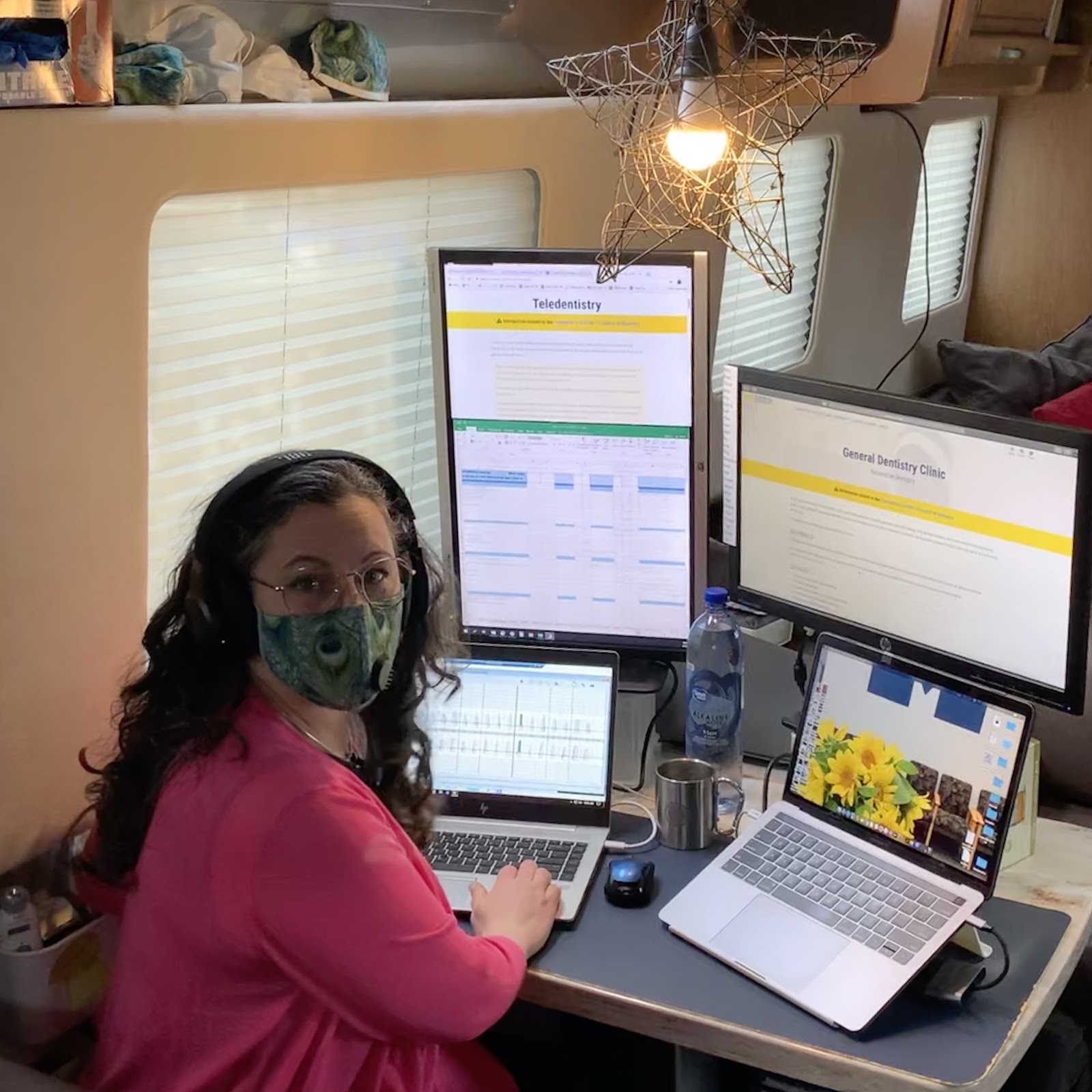
Bliss Ledford, patient business associate for the Graduate General Dentistry Clinic, stays connected from her home office, an Airstream trailer at a campground near Ann Arbor.
- Communicating across the school with all the constituencies was as vital as it was difficult in the midst of an ever-changing crisis where answers were often difficult to immediately determine. The school created a COVID-19 information bank on its internal MiTools website. It contained regularly updated information from school leadership, links to university-wide communications, answers to frequently asked questions, copies of schoolwide emails, and links to video or audio replays of “townhall” meetings held online with students, staff and the entire school. The site also contained a comprehensive collection of instructions and best practices to help faculty, students and staff navigate the new online world.
- Even the time-honored tradition of thesis and dissertation defenses had to be changed. On March 25, doctoral student Min Oh was the first of what would be a steady stream of master’s and PhD students who were forced by the pandemic to hold their defenses online rather than in-person in front of a panel of their mentors, advisors and faculty members. Oh, who worked in the lab of Dr. Jacques E. Nör, successfully defended his project, “Perivascular niche and self-renewal of dental pulp stem cells,” via a BlueJeans teleconference.
Through all of the countless changes and non-stop decisions that have been made in the last four months, the most impressive aspect has been the commitment, adaptability and positive approach of the entire dental school community, McCauley said. “This is still an ongoing story, but it is already one of the most remarkable chapters in the 145-year history of the school. One way to measure the strength of any organization is how it deals with difficult times and change. From the start, our community rallied together and worked tirelessly to find innovative solutions that would maintain the school’s mission and high standards. It is the sort of determined teamwork, focus and creativity that made the school an early leader in dental education, and it’s how we will continue to deal with this pandemic challenge moving forward.”
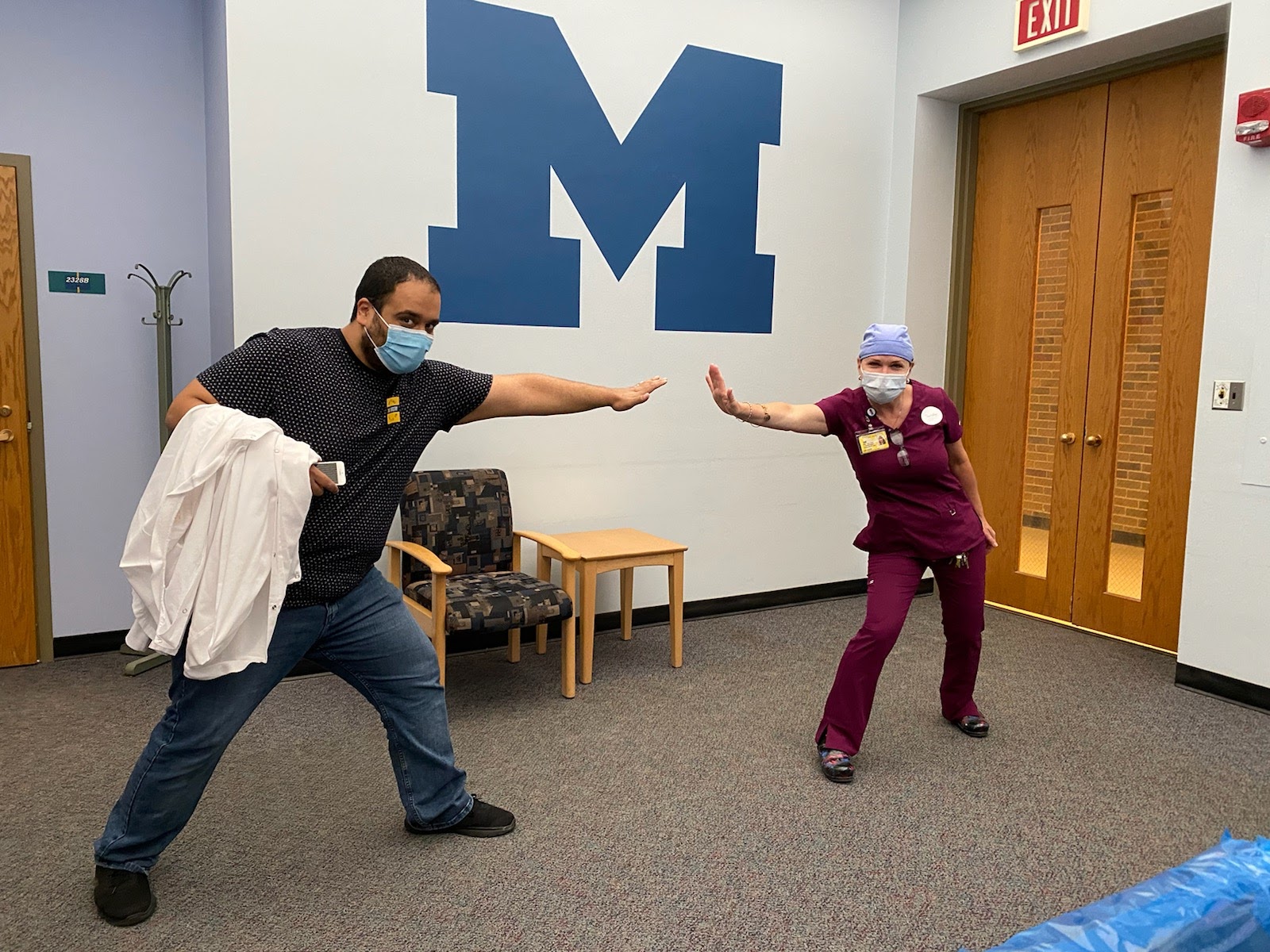
Dr. Naif Ganadely, a student in the graduate restorative dentistry program, and Lisa Davis, operations manager for the Graduate General Dentistry Clinic, observe social distancing by sharing an "air high-five" in the waiting room.

